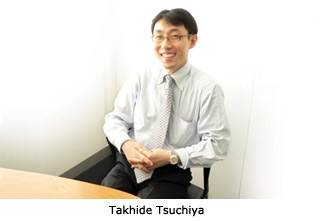With a formal education that spans management, economics and art—and a career that traverses two continents—Takahide Tsuchiya (HNZ’96) says good management comes down to being able to connect with people.

“Wherever you are, and whatever language you are speaking, you need to deal with people,” he observes.
Obviously, he’s doing a very good job of that—not to mention rising close to the top (literally) of the Japanese art world. Tsuchiya manages the Mori Arts Center Gallery in downtown Tokyo. The gallery is just one part of Roppongi Hills, a large-scale cultural and commercial complex that includes residences, retail stores, business offices, a television network headquarters, movie theaters and near the top of one of its many high-rises, an art gallery.
The Mori Gallery enjoys a reputation as one of Japan’s foremost museums, with its emphasis on cultural exchange and international exhibits.

“As a privately run institution with little public funding, we often face the pressure of balancing profitability with artistic and critical reputation,” he says. “We also need to consider the ‘synergy effect’ of cultural activities, retail shops and offices to promote business within the complex, which can be a challenge.”
Tsuchiya earned a master’s degree in arts management from Carnegie Mellon, where he recalls two years of valuable study that afforded him the opportunity “to think about how arts organizations, or museums more specifically, should be supported by society.” Tsuchiya says, “While one of the main managerial concerns of arts organizations in the United States is fund raising, those organizations also can benefit from tax systems and public funding programs, which have been implemented to support them at the local and national levels.”
Much of his early understanding of museums and their missions came from his internship at The Andy Warhol Museum in Pittsburgh, a venue whose size and approach were a welcome introduction to the field of arts management. “If my first experience with a museum were at a large-scale encyclopedic museum, it might have been more difficult to grasp the whole picture,” he says.
Tsuchiya has already made progress toward his goal of enhancing international cultural exchange. While at the Warhol Museum, he helped prepare a major retrospective exhibition of Andy Warhol’s work that later traveled to three cities in Japan. More recently, at the Mori Arts Center Gallery, he has been involved in several cross-cultural exhibitions, including “Giorgio Armani,” with the Guggenheim Museum in New York and “Leonardo da Vinci: The Codex Leicester,” on loan from the collection of Bill and Melinda Gates.
“All of the exhibitions were important in that they provided audiences in Japan with quality artistic experiences. It would be more ideal if the exhibition held here in Japan travels abroad to reciprocate in the future,” he says.
Related Links:
Master of Arts Management
Mori Arts Center
Andy Warhol Museum



